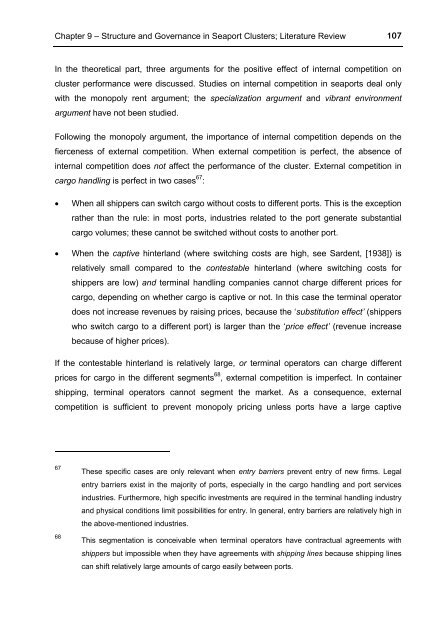The Performance of Seaport Clusters - RePub - Erasmus Universiteit ...
The Performance of Seaport Clusters - RePub - Erasmus Universiteit ...
The Performance of Seaport Clusters - RePub - Erasmus Universiteit ...
You also want an ePaper? Increase the reach of your titles
YUMPU automatically turns print PDFs into web optimized ePapers that Google loves.
Chapter 9 – Structure and Governance in <strong>Seaport</strong> <strong>Clusters</strong>; Literature Review 107<br />
In the theoretical part, three arguments for the positive effect <strong>of</strong> internal competition on<br />
cluster performance were discussed. Studies on internal competition in seaports deal only<br />
with the monopoly rent argument; the specialization argument and vibrant environment<br />
argument have not been studied.<br />
Following the monopoly argument, the importance <strong>of</strong> internal competition depends on the<br />
fierceness <strong>of</strong> external competition. When external competition is perfect, the absence <strong>of</strong><br />
internal competition does not affect the performance <strong>of</strong> the cluster. External competition in<br />
cargo handling is perfect in two cases 67 :<br />
• When all shippers can switch cargo without costs to different ports. This is the exception<br />
rather than the rule: in most ports, industries related to the port generate substantial<br />
cargo volumes; these cannot be switched without costs to another port.<br />
• When the captive hinterland (where switching costs are high, see Sardent, [1938]) is<br />
relatively small compared to the contestable hinterland (where switching costs for<br />
shippers are low) and terminal handling companies cannot charge different prices for<br />
cargo, depending on whether cargo is captive or not. In this case the terminal operator<br />
does not increase revenues by raising prices, because the ‘substitution effect’ (shippers<br />
who switch cargo to a different port) is larger than the ‘price effect’ (revenue increase<br />
because <strong>of</strong> higher prices).<br />
If the contestable hinterland is relatively large, or terminal operators can charge different<br />
prices for cargo in the different segments 68 , external competition is imperfect. In container<br />
shipping, terminal operators cannot segment the market. As a consequence, external<br />
competition is sufficient to prevent monopoly pricing unless ports have a large captive<br />
67 <strong>The</strong>se specific cases are only relevant when entry barriers prevent entry <strong>of</strong> new firms. Legal<br />
entry barriers exist in the majority <strong>of</strong> ports, especially in the cargo handling and port services<br />
industries. Furthermore, high specific investments are required in the terminal handling industry<br />
and physical conditions limit possibilities for entry. In general, entry barriers are relatively high in<br />
the above-mentioned industries.<br />
68 This segmentation is conceivable when terminal operators have contractual agreements with<br />
shippers but impossible when they have agreements with shipping lines because shipping lines<br />
can shift relatively large amounts <strong>of</strong> cargo easily between ports.

















